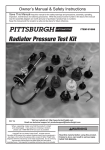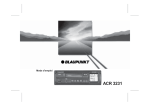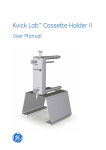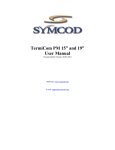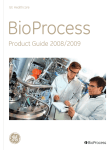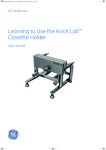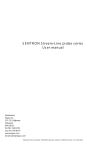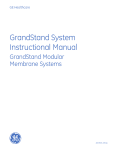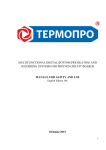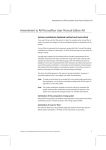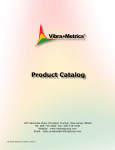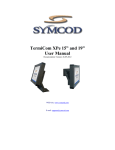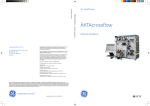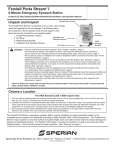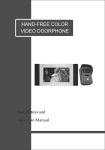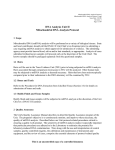Download Kvick Pilot and Process cassettes
Transcript
GE Healthcare Kvick Pilot and Process cassettes Instructions for use 11-0026-31 AB Table of contents About this user guide 3 Audience 3 Where to find more information 3 Safety 4 Warnings, cautions, and expert advice 4 Section 1—Cassettes Package contents Learning about cassettes Product labeling 5 5 5 Section 2—Using a cassette Introduction Preparing a cassette for use Recommended operating conditions Optimizing product recovery Cleaning a cassette after use Storing a cassette 6 6 7 7 7 8 Section 3—Cassette specifications Kvick Pilot specifications Kvick Process specifications Chemical compatibility Index 2 User Manual 9 9 10 11 About this user guide Where to find more information This user guide describes how to use Kvick™ Pilot and Kvick Process membrane cassettes. Topics include preparation for use, recommended operating conditions, cleaning and storing, and product specifications. GE Healthcare publishes several user guides that may be helpful in using Kvick brand products (Figure 1). Audience This user guide addresses the needs of scientists, process engineers, and technicians who operate pilot- and process-scale cross-flow systems. The level of information presented in this guide assumes the user possesses basic laboratory and technical skills, and has the knowledge and documentation to safely operate any user-supplied equipment used with the Kvick Pilot and Kvick Process cassettes. If you need assistance with the instructions in this guide, contact GE Healthcare for more information. You can download technical documents and learn more about GE Healthcare cassettes and cross-flow systems by visiting our website, www.gehealthcare.com. Cross Flow System Safety: Multilingual Safety Instructions— Describes conditions and actions that can cause bodily injury or equipment damage when using cross flow systems. Describes how to avoid the risks. Supplied with GE Healthcare cassette holders and systems. Available for downloading from the GE Healthcare website. MSDSs for glycerin, NaOH, and hydraulic fluid— Provides safe handling and disposal information. Available for printing and downloading from the GE Healthcare website. User Manual 3 Safety Anyone who works with the Kvick Pilot and Kvick Process cassettes should read, understand, and follow the instructions in this user guide. If any operator does not understand an instruction, they should stop working with the Kvick Pilot and Kvick Process cassettes and contact GE Healthcare for guidance. You should save these instructions and make them available to all users of the cassettes. GE Healthcare designed the Kvick Pilot and Kvick Process cassettes for laboratory- and pilot-scale filtration of biological solutions using Kvick Pilot and Kvick Process cassette holders under the conditions stated in this user guide. If you use the cassettes in a manner not specified by GE Healthcare, you may impair the protection provided by the system and cassettes. When using any pilot- or process-scale cross-flow equipment, the potential exists for personal injury unless you follow established safety procedures. When using GE Healthcare products, you should follow OSHA1, federal, state, and local safety regulations for equipment installation and operation. You should follow your company’s safety regulations. You should follow the specific safety instructions provided in this user guide and any original equipment manufacturer user guides provided with your system. Only qualified personnel who are adequately trained and who understand the operating instructions should install, operate, maintain, and inspect Kvick Pilot and Kvick Process cassettes. Warnings, cautions, and expert advice This user guide uses symbols and blocks of text to provide you with safety warnings and other important information: ® Safety WARNING: A safety warning flag describes conditions or actions that can cause bodily harm and describes how to avoid the risk. ® Expert Advice CAUTION: A caution flag describes conditions or actions that can damage equipment and describes how to avoid the risk. ® Expert Advice TIP: An expert advice flag provides you with information equipment efficiently or achieve the best results. Warning If you overpressurize a cross-flow system with compressed air during integrity testing, system components can rupture causing bodily harm. To avoid the rupture of a system component due to over pressurization with compressed air, use a pressure regulator to limit the pressure of your compressed air supply to the weakest component in your cross-flow system. Wear the appropriate personal protection devices when testing the system. 1 In the United States, OSHA is the Occupational, Safety, and Health Administration 4 User Manual If a cross-flow system leaks, it can release potentially hazardous process or cleaning fluids causing bodily harm. To prevent leaks and the release of potentially hazardous fluids, limit feed pressure on GE Healthcare cross-flow systems to 4 barg (60 psig), periodically check parts for wear, and ensure you assemble the components correctly. To monitor system pressure, GE Healthcare recommends that you install pressure gauges on the system as described in this user guide. Isolate and depressurize your system before disassembling it. Periodically inspect the system’s gaskets, seals, and connections for wear. Ensure you assemble the holder correctly following the instructions in this guide. Wear the appropriate personal protection devices and clothing when operating and cleaning the system. Warning Mishandling potentially hazardous process and cleaning solutions can cause bodily harm. To safely handle potentially hazardous process, cleaning, and storage solutions, read the material safety data sheets for the solutions you use. Follow the material safety data sheet instructions for safe handling and use the personal protection equipment required by your company, and local, state,and federal laws. Warning The cassette and cassette bag contain an aqueous solution containing 0.1 to 0.2 N NaOH and 20 to 22% glycerin by weight. When opening the cassette bag, follow the standard safety procedures for handling aqueous NaOH, including the use of safety glasses, safety gloves, and protective lab coat. To avoid unexpected spilling, hold the cassette package upright over a sink and trim the top of the cassette bag with scissors. Drain and dispose of the excess storage solution in accordance with environmental regulations. To avoid inadvertent contact with the storage solution after the cassette is removed from the bag, rinse the outside surface of the cassette with high purity water. Caution The following actions can damage cassettes: dropping on hard surfaces, other mechanical shock, excessive feed pressure, pressurizing the permeate ports, exposure to harsh chemical solutions, and freezing. If the cassette is subjected to any of these conditions, you should perform integrity testing and water flux on the cassette to check for internal damage. Caution Allowing ultrafiltration cassettes to dry out can permanently damage the membrane. To prevent damage from drying out during short periods of inactivity (1 to 3 days), wet out the membrane with buffer or saline solution. To prevent cracking of the membrane during long-term storage, follow the storage procedure on page 17. To prevent cracking during use, do not flow compressed air through the system for more than a few minutes. Chapter 1 Cassettes Package contents Cassette boxes include the following components: Cassette in sealed plastic bag Cassette gasket Certificate of compliance User Guide Learning about cassettes The two sizes of Kvick Pilot and Kvick Process cassettes share design components, including inlet and outlet ports, labeling, and alignment notches (Figure 2). 1. Inlet (feed) port 2. Outlet (retentate) port 3. Permeate port 4. Cassette information (see Figure 3) 5. Alignment notches 6. Incorporated gasket Figure 1. The main parts of a Kvick Pilot cassette Product labeling Cassette identifying information is laser engraved on the side of the cassette. The information describes the following: manufacturer, lot number, cassette type (Kvick Pilot or Kvick Process), part number, pore size (10K, 30K, 50K, etc.) and the membrane area in square feet and square meters (Figure 3). Figure 2. Identifying information printed in the side of cassettes User Manual 5 Chapter 2 Using a cassette Introduction Preparing a cassette for use Preparing a cassette for use can be as simple as rinsing the cassette with deionized water. In critical applications, cassette preparation may include: (1) documenting the performance of the cassette, (2) ensuring the integrity of the cassette, and (3) sanitizing the cassette. Opening the cassette bag safely This user guide describes how to open and rinse the cassette with water—the most basic step of cassette preparation. The user guides for GE Healthcare cassette holders describe the other preparatory steps you may want to complete for critical applications. ® Safety WARNING: The cassette and cassette bag contain an aqueous solution containing 0.1 to 0.2 N NaOH and 20 to 22% glycerin by weight. When opening the cassette bag, follow the standard safety procedures for handling aqueous NaOH, including the use of safety glasses, safety gloves, and protective lab coat. To avoid unexpected spilling, hold the cassette package upright over a sink and trim the top of the cassette bag with scissors. Drain and dispose of the excess storage solution in accordance with environmental regulations. To avoid inadvertent contact with the storage solution after the cassette is removed from the bag, rinse the outside surface of the cassette with high purity water. ® Expert Advice TIP: Expert users normally establish pump curves for the system configuration they plan to use. By establishing a pump curve, they can quickly and accurately set the pump speed to achieve the recommended flow rate during processing. To determine the flow rate without a pump curve, you would have to disconnect the retentate line and measure the flow rate using a graduated cylinder and stop watch. If you need help in developing a pump curve, contact GE Healthcare technical support team. 6 User Manual The cassette and cassette bag contain an aqueous solution containing 0.1 to 0.2 N NaOH and 20 to 22% glycerin by weight. When opening the cassette bag, follow the standard safety procedures for handling aqueous NaOH, including the use of safety glasses, safety gloves, and protective lab coat. To avoid unexpected spilling, hold the cassette package upright over a sink and trim the top of the cassette bag with scissors. Drain and dispose of the excess storage solution in accordance with environmental regulations. To avoid inadvertent contact with the storage solution after the cassette is removed from the bag, rinse the outside surface of the cassette with high purity water. If you allow an ultrafiltration cassette to dry out, the membrane will be damaged. Therefore, do not store the cassette without rewetting it with an approved storage solution. Rinsing the storage solution from the cassette At a minimum, before using a new or used-and-stored cassette, rinse the storage solution from the cassette following these steps: 1. Following the safety instructions above, open the cassette bag, drain the cassette, and rinse the storage solution from the exterior of the cassette with high purity water. 2. Install the cassette in the cassette holder. (See your cassette holder’s user guide for specific installation instructions.) 3. Configure the system so that the retentate and permeate lines discharge to waste (Figure 4). Close the feed, retentate, and permeate valves. 4. Fill the reservoir with an appropriate volume of DI water or WFI (5 liters per 0.09 mÇ [1.0 ftÇ] of membrane area). Figure 3. Typical setup for rinsing cassettes or the initial flow of cleaning solution at the start of cleaning ® Expert Advice Optimizing product recovery CAUTION: Using tap water to flush or rinse cassettes can plug the pores of the membrane with the relatively large particulates (rust, dirt, minerals, bacteria, etc.) found in tap water. To prevent plugging the pores of the cassette, always use deionized water or water-for-injection when rinsing or flushing the cassette, or when making up cleaning solutions or adding dilution water to process fluids. You can optimize product recovery by reducing the cross-flow rate at the end of your process step. When you are done concentrating your product, reduce the cross-flow rate to 1/10 of the recommended processing cross-flow rate. Close the filtrate valve or reduce the feed pressure to 0.3 barg (5 psig). Retentate pressure should be 0 barg (0 psig). Circulate the remaining product for 15 minutes. This procedure will help recover product buildup from the surface of the membrane. 5. Open the feed and retentate valves and close the permeate valve. Pump about 10 percent of the water through the retentate line to waste, maintaining a transmembrane pressure of 0.35 barg (5 psig). 6. Open the permeate valve and close the retentate valve and pump the remaining water through the permeate line to waste, maintaining a feed pressure of the 0.35 barg (5 psig). 7. If needed for your application, sample and analyze the last volume of drain water pumped from the system for traces of storage or cleaning solution.2 Repeat steps 4 through 7 until you achieve the needed level of storage solution removal. 8. If needed, circulate buffer to prepare the cassette and system for processing. Recommended operating conditions When using your cassette, fully open the permeate valve and adjust your pump speed and retentate valve to achieve the crossflow rate required by your process. If your feed is particularly viscous or has other unusual physical characteristics, contact the technical support team at GE Healthcare for assistance. Other recommended operating parameters include these: • pH range, long-term (storage)—2 to 13 • pH range, short-term (cleaning)—1 to 14 • Maximum operating temperature—50 °C • Maximum inlet pressure—4 barg (60 psig) Cleaning a cassette after use You can reuse a cassette if you clean and store it properly. To clean a used cassette, flush it with buffer, WFI, or DI water as described in Preparing a cassette for use on page 13. Then clean the cassette following these steps: 1. Configure the system so that the retentate and permeate lines discharge to waste (Figure 4). Close the feed, retentate, and permeate valves. 2. Prepare the appropriate volume of a cleaning solution (1.5 to 2 liters per 0.09 mÇ [1.0 ftÇ] of membrane area). Table 1 describes recommended cleaning solutions. 3. Fill the feed reservoir with the cleaning solution. 4. Open the feed and retentate valves and pump about 10 percent of the cleaning solution through the retentate line to waste. Open the permeate valve and close the retentate valve and pump about 10 percent of the cleaning solution through permeate line to waste. 5. Stop the pump and configure the system so that the retentate and permeate lines discharge into the feed reservoir (Figure 5). Open the feed, retentate, and permeate valves. 6. Start the pump. Adjust the retentate valve and pump speed to obtain the cross flow rate required for cleaning. 2 You can analyze the rinse water using analytical techniques or with residual indicator kits readily available from scientific equipment supply houses. User Manual 7 7. Circulate the cleaning solution for 30 to 60 minutes. 8. Drain the cleaning solution from the system using the drain line. 9. Flush it with buffer, WFI, or DI water as described in Preparing a cassette for use on page 00 Table 1. Recommended cleaning solutions Cleaning agent Cleaning conditions Membrane type 1.5% Terg-A-Zyme® Contact time ? 60 minutes Temperature ? 35°C (95°F) Polyethersulfone and PolysulfoneA 1.5% Alconox® detergent Contact time ? 60 minutes Temperature ? 40°C (95°F) Polyethersulfone and Polysulfone 0.1 to 0.5N sodium hydroxide Contact time ? 60 minutes Temperature ? 40°C (113°F) Polyethersulfone and Polysulfone 200 to 300 ppm sodium hypochlorite in 0.1 to 0.5N sodium hydroxide Contact time ? 60 minutes Temperature ? 20°C (68°F) Polyethersulfone and Polysulfone A Polysulfone membrane is used in GE Healthcare Hollow Fiber cartridges. Storing a cassette Before storing your cassette, clean it (see page 16) and flush it with a storage agent to keep the membrane wet and minimize biological growth: • For storage less than 3 days, use clean water or 0.1 N NaOH • For storage from 3 days to 6 months, use 0.1N NaOH • For storage longer than 6 months, use a storage solution of 0.1 N NaOH and store the cassette at 4°C. For long-term storage (more than ten days), remove the cassette from the holder and place it into an air-tight plastic tub or heavyduty, zip-lock-type plastic bag. Add about 50 to 100 ml of the storage agent to the plastic bag and seal it. Place the sealed bag in a protected location at a temperature less than 25°C (77°F). Cold storage (but above freezing) provides the optimal storage conditions. For short-term storage (five to ten days), keep the cassette in the holder and circulate the storage solution for 10 to 15 minutes, close the system valves, disconnect the electrical power to the feed pump, and ensure the feed reservoir is properly sealed. Reduce the clamping pressure as low a possible while avoiding leaks. 8 User Manual Figure 4. Typical setup for extended recirculation of cleaning solution during cleaning. Chapter 3 Cassette specifications Kvick Pilot specifications Kvick Process specifications Ordering information Ordering information Pore size NMWC* Code number Model number Membrane area m2 ft2 Pore size NMWC* Code number Model number Membrane area m2 ft2 56-4115-69 UFEPT 0005 025 ST 0.23 2.5 5,000 56-4115-55 UFEPR 0005 300 ST 2.79 30 5,000 56-4115-70 UFEPT 0010 025 SE 0.23 2.5 10,000** 56-4115-56 UFEPR 0010 300 SE 2.79 30 10,000** 56-4115-71 UFEPT 0010 025 ST 0.23 2.5 10,000 56-4115-57 UFEPR 0010 300 ST 2.79 30 10,000 56-4115-72 UFEPT 0030 025 ST 0.23 2.5 30,000 56-4115-58 UFEPR 0030 300 ST 2.79 30 30,000 56-4115-73 UFEPT 0050 025 ST 0.23 2.5 50,000 56-4115-59 UFEPR 0050 300 ST 2.79 30 50,000 56-4115-75 UFEPT 0100 025 ST 0.23 2.5 100,000 56-4115-63 UFEPR 0100 300 ST 2.79 30 100,000 * Nominal molecular weight cutoff ** Tighter 10kD membrane than the regular 10kD * Nominal molecular weight cutoff ** Tighter 10kD membrane than the regular 10kD Materials of construction: Materials of construction: Membrane—polyethersulfone Screen—polypropylene Encapsulent and encapsulated gasket—silicone Preservative solution—0.1 to 0.2 N NaOH and 20 to 22% glycerin Membrane—polyethersulfone Screen—polypropylene Encapsulent and encapusulent gasket—silicone Preservative solution—0.1 to 0.2 N NaOH and 20 to 22% glycerin Recommended operating conditions: Recommended operating conditions: pH range, long-term (storage)—2 to 13 pH range, long-term (storage)—2 to 13 pH range, short-term (cleaning)—1 to 14 pH range, short-term (cleaning)—1 to 14 Maximum operating temperature—50 °C Maximum operating temperature—50°C Maximum inlet pressure—4 barg (60 psig) Maximum inlet pressure—4 barg (60 psig) User Manual 9 Chemical compatibility GE Healthcare Kvick Pilot and Kvick Process cassettes are resistant to a wide range of chemicals. However, you can damage the cassettes by exposing them to chemicals incompatible with their materials of construction. The following table provides a general guide to the chemical compatibility of polyethersulfone, primary material of construction. Polyethersulfone Solution Acetic acid (10 %) Resistant Hydrochloric acid (0.1%) Limited resistance Acetic acid (1.7 M) Resistant Isopropyl alcohol Resistant Ammonium hydroxide (<5%) Resistant Methanol (98 %) Resistant Benzyl benzoate Limited resistance Mineral oil Resistant Butanol Resistant Nitric acid (0.1 M) Resistant Butyl acetate Limited resistance Ozone Limited Resistance Carbon tetrachloride Limited resistance Peracetatic acid (0.2 %) Resistant Chloroform Limited resistance Phosphoric acid (25%) Limited resistance Citric acid (10 %) Resistant Pyridine Limited Resistance Dichloroethylene Not resistant Sodium chloride (0.5 M) Resistant1 Diethyl ether Resistant Sodium hydroxide (1M) Resistant2 Ethanol (10 %) Resistant1 Sulfuric acid (25 %) Limited resistance Ethanol (20 %) Resistant1 Toluene Limited resistant Ethanol (40 %) Resistant1 Trichloroacetic acid (10 %) Limited resistant Ethyl ether Resistant Triethanolamine Resistant Ethylene glycol (50%) Resistant Urea Limited Resistance Formaldehyde (1.7 M) Resistant Xylene Limited Resistance Formic acid (10%) Resistant Fructose (saturated) Resistant Gelatine Resistant Glucose Resistant Glycerol Resistant Guanidine hydrochloride Limited resistance Hexane Limited resistance Solution 1 As the concentration of ethanol increases, cassette flux rate decreases. 10 User Manual Polyethersulfone 1 Sodium chloride can cause corrosion on stainless steel at pH less than 5. Do not usesodium chloride in storage solutions. 2 Maximum recommended exposure is 4 hours. Index A N NaOH, 9, 13, 14, 18 Audience, 4 NaOH safety, 9, 13, 14 C O Cassettes, 10 Opening cassette bags safely, 9, 13, 14 chemical compatibility, 22 cleaning, 17 damaging, 9 design, 10 identifying information, 12 keeping wet to avoid damage, 9 not using tap water, 15 opening the bag safely, 9, 13, 14 operating conditions, 16, 20, 21 optimizing product recovery, 17 preparing for use, 13 rinsing the storage solution, 14 safety, 9, 13, 14 storage solution, 9, 13, 14 storing, 18 Operating conditions, 20, 21 Operator qualifications, 4 Optimizing product recovery, 17 Ordering Information, 20, 21 P Package contents, 10 Preparing a cassette for use, 13 Product labeling, 12 Proper use of cassette, 6 Pump dry running, damage, 9 Caution flags, 7 Recovering product of interest, 17 Chemical compatibility of cassettes, 22 Reusing cassettes, 17 Cleaning cassettes, 17 Contact information, 2 Rinsing storage solution from the cassette, 14 Contact information, 4 S Customer Support, 4 Safety, 5, 7 cleaning solutions, 8 leaks, 8 NaOH, 9, 13, 14 opening cassette bags, 9, 13, 14 overpressurization, 8 storage solution, 9, 13, 14 D Damaging cassettes, 9 Documentation, 4, 10 E Email address, 4 Expert advice flags, 7 Specifications Kvick Pilot, 20 Kvick Process, 21 G Glycerin, 9, 13, 14, 18 Storing casssettes, 18 I Information, 4 T Technical support, 4 K Kvick Pilot specifications, 20 Temperature and pressure limits, 16 Kvick Process specifications, 21 U User guide introduction, 4 L Labeling of cassettes, 12 User guides, 4, 10 Literature, 4 W M Materials of construction Kvick Pilot, 20 Kvick Process, 21 Warning flags, 7 Warnings, cautions, and expert advice, 7 Web site, 4 Who should use this guide, 4 Model numbers, 20, 21 User Manual 11 www.gehealthcare.com Global Headquarters GE Healthcare Little Chalfont Buckinghamshire, U.K. HP7 9NA GE, imagination at work and GE monogram are trademarks of General Electric Company. Kvick is a trademark of GE Healthcare companies. Alconox and Terg-A-Zyme are registered trademarks of Alconox, Inc. All goods and services are sold subject to the terms and conditions of sale of the company within GE Healthcare which supplies them. GE Healthcare reserves the right, subject to any regulatory and contractual approval, if required, to make changes in specifications and features shown herein, or discontinue the product described at any time without notice or obligation. © 2006 General Electric Company - All rights reserved. GE Healthcare Bio-Sciences AB, a General Electric Company. GE Healthcare Bio-Sciences AB Björkgatan 30, 751 84 Uppsala, Sweden GE Healthcare Europe GmbH Munzinger Strasse 5, D-79111 Freiburg, Germany GE Healthcare UK Ltd Amersham Place, Little Chalfont, Buckinghamshire, HP7 9NA, UK GE Healthcare Bio-Sciences Corp 800 Centennial Avenue, P.O. Box 1327 Piscataway, NJ 08855-1327, USA GE Healthcare Bio-Sciences KK Sanken Bldg. 3-25-1, Hyakunincho, Shinjuku-ku, Tokyo 169-0073, Japan Asia Pacific Tel +65 6275 1830 Fax +65 6275 1829 Australasia Tel + 61 2 9899 0999 Fax +61 2 9899 7511 Austria Tel 01/57606-1619 Fax 01/57606-1627 Belgium Tel 0800 73 888 Fax 02 416 82 06 Canada Tel 800 463 5800 Fax 800 567 1008 Central, East, & South East Europe Tel +43 1 972720 Fax +43 1 97272 2750 Denmark Tel 45 16 2400 Fax 45 16 2424 Finland & Baltics Tel +358 (0)9 512 39 40 Fax +358 (0)9 512 39 439 France Tel 01 69 35 67 00 Fax 01 69 41 96 77 Germany Tel 089 96281 660 Fax 089 96281 620 Greater China Tel +852 2100 6300 Fax +852 2100 6338 Italy Tel 02 27322 1 Fax 02 27302 212 Japan Tel +81 3 5331 9336 Fax +81 3 5331 9370 Latin America Tel +55 11 3933 7300 Fax +55 11 3933 7304 Middle East & Africa Tel +30 210 9600 687 Fax +30 210 9600 693 Netherlands Tel 0800 82 82 82 1 Fax 0800 82 82 82 4 Norway Tel 815 65 555 Fax 815 65 666 Portugal Tel 21 417 7035 Fax 21 417 3184 Russia & other C.I.S. & N.I.S Tel +7 (495) 956 5177 Fax +7 (495) 956 5176 Spain Tel 93 594 49 50 Fax 93 594 49 55 Sweden Tel 018 612 1900 Fax 018 612 1910 Switzerland Tel 0848 8028 12 Fax 0848 8028 13 UK Tel 0800 616928 Fax 0800 616927 USA Tel 800 526 3593 Fax 877 295 8102 11-0026-31 AB 09/2006












